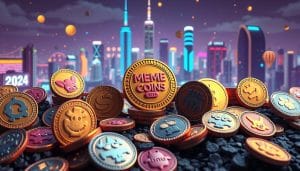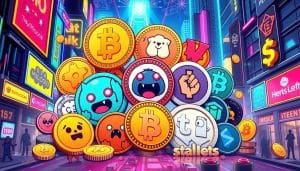You’re probably wondering what the future of tokenized art looks like. After all, it’s a relatively new concept and one that is quickly gaining traction in the world of art collecting. Tokenized art is unique because it gives artists and collectors alike unprecedented access to the global market – allowing them to buy, sell, and trade artwork as easily as cryptocurrencies. In this article, we’ll explore how tokenized art works, its benefits for artists, collectors, and consumers alike – plus the challenges associated with this innovative type of digital asset. So stick around to discover what the future has in store for tokenized art!
Table of Contents
ToggleOverview of Tokenized Art
Tokenized art is the future; it’s a digital canvas that allows creators to bring their artwork to life and immerse audiences in their vivid, imaginative worlds. This innovative form of art has opened up new possibilities for both artists and buyers alike. By tokenizing artwork, creators no longer have to worry about losing ownership or having their work stolen, as the digital security offered through tokenization provides unparalleled protection of intellectual property rights. Additionally, buyers can now purchase physical tokens that represent fractions or whole pieces of artwork, giving them access to unique works without shelling out a fortune. All this adds up to demonstrate how tokenized art offers undeniable benefits in terms of digital ownership and security. Looking ahead, it’s clear that this technology will continue to revolutionize the way we experience and monetize art – making it an exciting new frontier for artists and collectors alike.
Benefits for Artists
Tokenized art provides artists with greater control over their work, access to new markets, and increased transparency and trust. You can now own a piece of artwork without worrying about its authenticity or potential for forgery. Moreover, tokenization opens up the possibility of selling artwork in fractional amounts, which increases access to a larger pool of buyers. The technology also ensures that transactions are secure and transparent, giving both artists and collectors peace of mind when engaging in these transactions.
Greater control over artwork
With tokenized artwork, you gain greater control over your creative works. This is because the technology provides a secure digital authentication for each piece of art, ensuring that it can be traced to its original artist. You are able to:
- Track ownership:
- Monitor who has access to the work and who has purchased it.
- Determine how many copies of the artwork exist at any given time.
- Protect authenticity:
- Establish and verify the legitimacy of the artwork’s origin.
- Prove that you are in fact its creator.
This heightened sense of security gives artists more confidence in their work while allowing them access to new markets with increased potential for monetization opportunities.
Access to new markets
Thanks to tokenized artwork, you can now open up opportunities for your work to be seen in entirely new markets. Tokenization of artwork can provide a unique alternative financing structure that allows artists to access global reach and connect with potential buyers from all over the world. This opens up exciting opportunities for creators who would have otherwise had limited options when it comes to selling their artwork. Moreover, tokenized art also gives buyers more confidence in their purchase, as they are able to trace the provenance and ownership history of each piece. With increased transparency and trust, both buyers and sellers benefit from an improved system that unlocks new possibilities for artistic expression.
Increased transparency and trust
You can trust that tokenized artwork gives buyers a greater level of transparency into the provenance and ownership history, so you can feel confident in your purchase. Tokenized art offers several advantages compared to traditional methods of buying and selling art:
- Enhanced security – As each piece of artwork is represented by a unique token on the blockchain, it ensures that the asset is secure and immutable from any fraudulent activities.
- Improved efficiency – Transactions are processed faster and with less paperwork than before as all information associated with an artwork is stored securely on the blockchain.
- Increased trustworthiness – Buyers have access to complete ownership records which helps them verify the authenticity of each artwork they buy or sell online.
- More accurate pricing – The transparent nature of tokenization allows buyers to receive more accurate pricing for their purchases since all transactions are recorded on the blockchain ledger in real time.
These features provide buyers with increased confidence in their investments, allowing them to make smarter decisions when trading artwork digitally. From improved security measures to more efficient transactions, tokenized art has many benefits that offer enhanced trust for both collectors and sellers alike – making it an ideal way to invest in art for years to come.
Benefits for Art Collectors
As an art collector, you have the chance to invest in pieces of amazing and exclusive artwork. You can access these pieces faster than ever before with tokenized art transactions. Not only will you be able to purchase unique works of art, but also gain a financial return from them, allowing for even more investment opportunities within the world of art collecting.
Access to exclusive pieces
Experience a unique opportunity to own exclusive pieces of art tokenized on the blockchain! With fractional ownership, those who invest in art can now have access to a wider variety of artwork that they otherwise would not be able to afford. Furthermore, with royalty rights, investors also receive an added bonus when their piece is sold or licensed by another artist.
Through this new form of investing in art, collectors have the chance to purchase and showcase exclusive pieces from renowned artists. Not only do these investments provide collectors with the satisfaction of having a rare work of art but they also appreciate in value over time. Additionally, these investments offer greater liquidity than traditional artwork as investors can trade them on secondary markets more easily. Transitioning into the next section about investing in art without saying “step” allows one to explore opportunities for increased financial returns on their investments while simultaneously maintaining ownership rights over their purchases.
Investing in art
Investing in art can be an exciting way to diversify your portfolio and gain financial returns while expanding your collection. With the advent of tokenized art, digital ownership of artwork has become more accessible and secure through smart contracts. Tokenization also allows investors to quickly and easily transfer ownership of their artwork with faster transactions due to its decentralized nature. Investing in art is no longer limited to the world’s wealthiest individuals, but is now open for anyone looking to build a diverse portfolio or add exclusive pieces to their collection. By leveraging tokenized art, investors have access to more liquidity than ever before without sacrificing quality or authenticity.
Faster transactions
Tokenized art enables investors to quickly and securely transfer ownership of their artwork with fast, frictionless transactions. Real-time payments and automated smart contracts are the driving forces behind this process. Transactions occur in a matter of milliseconds, eliminating the delays associated with traditional paper-based transfers. With its efficiency and cost savings, tokenization is set to revolutionize the art market by facilitating quick and secure settlements between buyers and sellers. As tokenized art continues to develop, it will become an increasingly attractive option for investors looking to get into the market faster than ever before. With these advancements come new challenges as well as risks that must be carefully considered before investing in tokenized artwork.
Challenges and Risks
Though tokenized art offers many potential benefits, it also comes with certain unique risks and challenges that must be addressed:
- Tokenization complexity – the process of tokenizing artwork is extremely complex, as it involves combining digital tokens with legal contracts to create a new piece of art that is legally recognized.
- Ownership complexities – due to the decentralized nature of blockchain technology, ownership of tokenized art can be difficult to verify since there is no centralized authority governing it.
- Security vulnerabilities – since tokenized art exists on the blockchain, any security breach could put it at risk for being stolen or compromised in some way.
These are all important considerations when contemplating the future of tokenized art, and should not be taken lightly when making decisions about its viability and potential impact on the world of digital art. By understanding these risks and challenges thoroughly, we can ensure that our efforts to bring this technology to life are successful and secure in the long run.
The Future of Tokenized Art
You may have heard of tokenized art – an emerging concept in the art world that is being fueled by blockchain technology. This new approach to the art market has the potential to revolutionize how we think about and value digital art, creating new opportunities for buyers, sellers, and creators alike. As more people become aware of this exciting development, it is likely that tokenized art will become increasingly adopted and further shape the future of the art world.
Potential impact on the art market
By tokenizing art, you gain the power to make a lasting impression on the art market. This could be done by leveraging influencer marketing and automation trends to drive adoption of blockchain technology. You can tap into an audience that wasn’t previously available to traditional artwork and use modern tools to manage it all. Tokenized art may have the potential to expand the reach of artists, increase demand for their work, and ultimately revolutionize how we value artistic expression in the digital age. By democratizing ownership of unique works, tokenized art has the power to disrupt existing models of ownership and reshape what it means to purchase artwork in today’s world.
Potential adoption of blockchain technology
As the art market continues to develop, blockchain technology has the potential to revolutionize the way artwork is bought and sold. Through open platforms and smart contracts, tokenized art could be adopted by artists and collectors alike in order to track ownership rights for digital assets. This type of technology not only ensures authenticity but also provides a secure method of transferring ownership without the need for an intermediary.
The adoption of tokenized art can also create opportunities for greater collaboration between creators and consumers which could lead to new forms of engagement with artwork. By using blockchain-enabled platforms, artists can create their own unique tokens that can provide access to exclusive content or merchandise that was previously unavailable in traditional markets. The possibilities are endless, as these technologies become more widely available they have the potential to redefine how we interact with artwork.
Impact of digital art
With the emergence of digital art, you can experience artwork in a whole new way – like taking a journey through an ever-changing landscape. The impact of digital art is far-reaching, as its artistic value and creative rights are safeguarded on blockchain technology. Digital art provides unprecedented opportunities for creators to showcase their works and become more visible within the industry. Furthermore, it allows for broader accessibility by giving viewers from all over the world access to this artwork anytime, anywhere. This has enabled artists to express themselves in ways that would have otherwise been impossible due to geographical or technological barriers. With these benefits comes potential challenges such as copyright infringement and loss of control over ownership rights; however, with the right technical infrastructure in place these risks can be mitigated. As we look into the future of tokenized art, it’s clear that this will open up many possibilities for both creators and buyers alike – offering unparalleled levels of transparency and trust between them. With these advantages at hand, digital art looks set to continue revolutionizing our visual landscape in years to come. Taking into account all these aspects, it’s easy to see how transitioning to a tokenized model could create immense value for those involved in the art world – now let us take a look at what steps need to be taken in order get started.
Steps to Get Started
Gaining an initial understanding of the steps to get started with tokenized art is essential for anyone looking to join this innovative space. Tokenizing artwork has revolutionized the art industry by globalizing and seamlessly integrating it into the tech-driven tokenizing economy. The first step in getting involved is to familiarize yourself with platforms that offer digital media, such as Ethereum, Waves, and NFTs. These websites provide resources that can help you determine what type of artwork you want to create or buy. Additionally, these sites also offer tutorials and support for users who are new to the concept of digital art. After becoming more comfortable with digital media, research how different tokens can be used in creating and selling digital artwork. It is important to understand all components associated with tokenization before investing any money into a project or artwork piece. Finally, it is important to stay up-to-date on developments related to blockchain technology and its effects on ownership rights surrounding your work – such as copyright law changes – so you can protect yourself from potential legal issues down the line. With a basic understanding of how tokenization works and its applications within the art world, artists are now able to enter a whole new realm of creative possibilities!





















